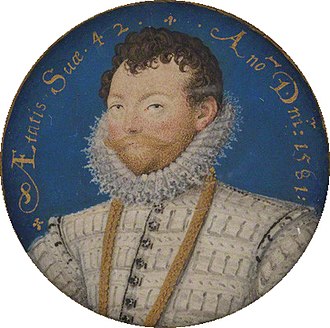Colonists Leave Roanoke Island, 1586
 |
| 1585 map of the area |
The story begins on March 25, 1584, when Queen Elizabeth granted a Royal Charter to Sir Walter Raleigh. He was given seven years. During that time he needed to establish a settlement in Virginia, or he would lose his right to do so. Both the Queen and Raleigh were anticipating that they would be able to gather riches from the New World. They also wanted a base for their privateers, who were charged with raiding the Spanish.
Raleigh never visited Virginia -- or any of North America. He did, however, lead several expeditions to South America, searching for gold in the legendary city of El Dorado. He sent an expedition in April, which arrived on July 4th, and made the acquaintance of the local tribes, the Secotans and the Croatans. The ship returned to England (leaving the settlers behind) and brought back two Croatans to Raleigh, who furnished him with information about the place.
In April of 1585 Raleigh sent five more ships to Roanoke. The Englishmen had barely started exploring the area when an incident occurred. A silver cup had vanished from the English settlement, and the natives were blamed for stealing it. In retaliation, the English sacked and burned an Aquascogoc village.
 |
| Sir Francis Drake -- brought them home. |
 |
| Sir Walter Raleigh -- protecting his interests. |
Garfield Debuts, 1978
 |
| Jim Davis, creator of Garfield. ©Connormah/Wikimedia Commons |
Garfield's creator, Jim Davis, was no stranger to cartooning -- or to cats, for that matter. The feisty hero of the strip is based on the 25 or so cats he knew growing up on his parents' Black Angus farm in Fairmount, Indiana. Garfield's name, however, as well as certain aspects of his personality, comes from Davis's grandfather, James A. Garfield Davis, whom Davis remembers as a "large cantankerous man."
As a child, Davis suffered from allergies and asthma -- a rough problem to have on a cattle farm. He spent a lot of time inside, and learned that he loved to draw. After high school, he attended Ball State University, where he majored in art and business.
Davis's first job after college was at an advertising agency, but he soon found something more to his liking. Tom K. Ryan, a cartoonist who lived in Muncie, Indiana, needed an assistant. Ryan's strip was called Tumbleweeds, and Davis learned a lot about the business from him.
Jim Davis's first solo cartoon was called Gnorm Gnat. It ran for five years in a local Indiana newspaper, but he was never able to syndicate it. One editor told him, "Your art is good, your gags are great, but bugs -- nobody can relate to bugs!" Davis finished Gnorm Gnat by having a giant foot come out of the sky and crush him.
His next strip was Garfield. It was picked up by the United Feature Syndicate and was an instant success. Nevertheless, after it had run a few months, one Chicago paper decided to cancel it and try something else. 1300 angry fans wrote in. The strip was quickly reinstated.
By 1982, the strip was appearing in 100 newspapers, and by 1987, in 200. Today it runs in over 2600 newspapers, and it is estimated that 263,000,000 people read it every day.
No comments:
Post a Comment